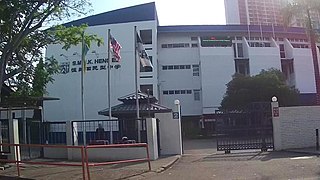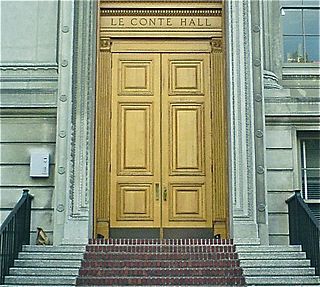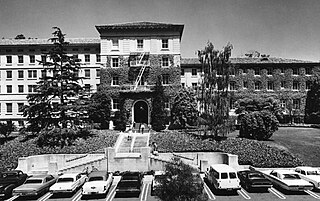
Wesleyan College is a private, liberal arts women's college in Macon, Georgia, United States. Founded in 1836, Wesleyan was the first college in the world chartered to grant degrees to women. It opened in 1839, two years after the opening of Mount Holyoke College.

Heng Ee High School is a Chinese conforming national-type Catholic secondary school located in George Town, Penang.

Marycrest College Historic District is located on a bluff overlooking the West End of Davenport, Iowa, United States. The district encompasses the campus of Marycrest College, which was a small, private collegiate institution. The school became Teikyo Marycrest University and finally Marycrest International University after affiliating with a Japanese educational consortium during the 1990s. The school closed in 2002 because of financial shortcomings. The campus has been listed on the Davenport Register of Historic Properties and on the National Register of Historic Places since 2004. At the time of its nomination, the historic district consisted of 13 resources, including six contributing buildings and five non-contributing buildings. Two of the buildings were already individually listed on the National Register.

Albany High School (AHS) in Albany, New York, United States, is a public high school with an enrollment of about 7,427 students for the 2023-2024 school year. The school is part of the City School District of Albany. It opened on September 7, 1868, as the Albany Free Academy. Albany High has been located at 700 Washington Avenue since 1974. The school is an International Baccalaureate school with an Advanced Placement program. The school newspaper is The Nest, the literary magazine is Inkblot, and the yearbook is Prisms.

Brisbane Central Technical College is a heritage-listed technical college at 2 George Street, Brisbane City, City of Brisbane, Queensland, Australia. It was built from 1911 to 1956. It became the Queensland Institute of Technology (QIT) in 1965, and then in 1987 that became the Queensland University of Technology. It was added to the Queensland Heritage Register on 27 August 1999.

Anderson Hall is the central administration building for Kansas State University in the city of Manhattan, Kansas, United States. Designed by Erasmus T. Carr, it was originally called the Practical Agriculture Building when the first wing was completed in 1879. In 1902, it was renamed "Anderson Hall" in honor of John Alexander Anderson, the second president of Kansas State Agricultural College. The building was added to the National Register of Historic Places in 1980.

Wesley W. Posvar Hall (WWPH), formerly known as Forbes Quadrangle, is a landmark building on the campus of the University of Pittsburgh in Pittsburgh, Pennsylvania, United States. At 744,695 square feet (69,184.4 m2) it is the largest academic-use building on campus, providing administrative offices, classrooms, lecture halls, a food court, and computer labs. The hall sits on the former site of Forbes Field and contains several artifacts, including the former stadium's home plate and one of two surviving Langley Aerodromes.

Penn State Shenango is a commonwealth campus of the Pennsylvania State University that is located in Sharon, Pennsylvania. Penn State Shenango is the only urban campus in the Penn State system, although some parts of Penn State Altoona that are located in the heart of Altoona's downtown are urban in nature.
The campus of the University of California, Berkeley, and its surrounding community are home to a number of notable buildings by early 20th-century campus architect John Galen Howard, his peer Bernard Maybeck, and their colleague Julia Morgan. Subsequent tenures as supervising architect held by George W. Kelham and Arthur Brown, Jr. saw the addition of several buildings in neoclassical and other revival styles, while the building boom after World War II introduced modernist buildings by architects such as Vernon DeMars, Joseph Esherick, John Carl Warnecke, Gardner Dailey, Anshen & Allen, and Skidmore, Owings and Merrill. Recent decades have seen additions including the postmodernist Haas School of Business by Charles Willard Moore, Soda Hall by Edward Larrabee Barnes, and the East Asian Library by Tod Williams Billie Tsien Architects.

Voorhees Mall is a large grassy area with stately shade trees on a block of about 28 acres (0.11 km2) located on the College Avenue Campus of Rutgers University near downtown New Brunswick, New Jersey. An eclectic mix of architectural styles, Voorhees Mall is lined by many historic academic buildings. The block is bound by Hamilton Street, George Street (north), College Avenue (south) and Seminary Place (west). At the mall's western end, across Seminary Place, is the campus of the New Brunswick Theological Seminary, whose history is intertwined with the early history of Rutgers University. Across Hamilton Street is the block called Old Queens, the seat of the university.

The Clapp-Langley-Crawford halls complex, comprises three inter-connected buildings and the Life Science Annex that house the Department of Biological Science and the Department of Neuroscience at the University of Pittsburgh in Pittsburgh, Pennsylvania, United States.

The Keele Campus is the main campus of York University in the North York district of Toronto, Ontario, Canada. It occupies roughly 1 square kilometre of land and is situated between Jane Street to the west, Keele Street to the east, Steeles Avenue West to the north and Finch Avenue West to the south. It is the largest post-secondary campus in Canada at 457 acres (185 ha).

McMillan Hall is a building on the campus of Washington & Jefferson College in Washington, Pennsylvania, United States. Built in 1793, it is the only surviving building from Washington Academy. It is the eighth-oldest academic building in the United States that is still in use for its original academic purpose and is the oldest surviving college building west of the Allegheny Mountains.

West Hall, built in 1917, is the oldest building at Valdosta State University and features a distinctive dome and Spanish-mission architecture. It is also the center of academic activity at VSU, with numerous classrooms, departments, and offices. West Hall is named in honor of Colonel W.S. West, who as a Georgia state senator, led the legislation for the creation of a college in Valdosta through the Georgia Senate and donated the property that is now the main part of campus to the state for use by the new institution.

LeConte Hall is the former name of a building on the campus of the University of California, Berkeley, which is home to the physics department. LeConte Hall was one of the largest physics buildings in the world at the time it was opened in 1924, and was also the site of the first atom collider, built by Ernest O. Lawrence in 1931.

California Hall is one of the original "classical core" Beaux-Arts-style Classical Revival buildings on the UC Berkeley campus. Construction began in 1903 under the lead of University Architect John Galen Howard after the university's adoption of the Phoebe Hearst master architectural plan for the Berkeley campus. The building opened in August, 1905. In 1982, it was named to the National Register of Historic Places, and is designated as an architectural feature of California Historic Landmark no. 946. In 1991, the Landmarks Preservation Committee of the City of Berkeley designated it Berkeley City Landmark no. 147. It currently houses the University of California Berkeley Chancellor's Office and the Graduate Division.

Dalby State High School is a heritage-listed state high school at 28B Nicholson Street, Dalby, Western Downs Region, Queensland, Australia. It was built from 1953 to 1954. It was added to the Queensland Heritage Register on 19 August 2016.

Warwick State High School is a heritage-listed state high school at Palmerin Street, Warwick, Southern Downs Region, Queensland, Australia. It was designed by Thomas Pye and Block A was built from 1914 to 1915. It is also known as Warwick Technical College and Warwick Intermediate School. It was added to the Queensland Heritage Register on 28 June 2018.

Cowell Memorial Hospital , is a historical former building in downtown Berkeley, California. The Cowell Memorial Hospital was built in 1930 and demolished in 1993. The building and it site was listed on the National Register of Historic Places on January 6, 1993. The hospital's entrance and Hospital's south wing were designed by Arthur Brown Jr. in the Neoclassical style and built in 1930. The hospital's east pavilion, designed by Weihe, Frick & Kruse and built in 1954. The hospital's north wing was designed by E. Geoffrey Bangs and built in 1960. After being demolished in 1993, a new building was built, Haas School of Business. The Cowell Memorial Hospital has a Residence Program from 1962 to 1974, noted for its work with disabled students. National Register of Historic Places was given both for the buildings and the contribution it health care work. Some of the work noted is the called the Cowell experiment, by Ed Roberts, The Father of Independent Living.




















